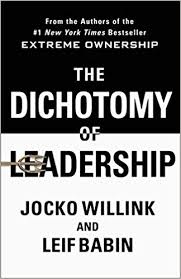More on this book
Community
Kindle Notes & Highlights
Read between
March 27 - April 6, 2022
It doesn’t matter if one element within the group does its job: if the team fails, everybody fails. But when the overall team wins, everybody wins. Everyone gets to share in that success.
No one leader can manage it all or make every decision. Instead, leadership must be decentralized, with leaders at every level empowered to make decisions, right down to the frontline troopers in charge of no one but themselves and their small piece of the mission.
to not take the risks inherent in conducting realistic training would put more SEALs in even greater danger when they deployed to combat zones not fully prepared for missions they would be called upon to execute.
There is no decision to make, I thought to myself. Even with all those other options in life, there was no other option for Seth. He knew what the right thing was. He knew his duty. And he did it.
True Extreme Ownership meant that all responsibility rested with me, as the leader. It didn’t mean that I, as the leader, personally did everything myself.
Let the teams and the leaders make decisions. But don’t completely check out. You don’t need to row the boat—or even steer it. You just have to make sure it is heading in the right direction.”
Every combat leader must be humble or get humbled.
just because someone hasn’t experienced the worst-case scenario in real life doesn’t mean it couldn’t happen.
Hard training is the solemn duty of trainers and leaders every day.
U.S. Army Colonel Glover Johns: “The harder the training, the more troops will brag.”
There is no growth in the comfort zone.
leaders must find the balance in training and focus on three critical aspects: realism, fundamentals, and repetition.
training is only as good as the instructors who are teaching it.
Training should be challenging. But only as a means to make your team better, to prepare them for the challenges they face in the real world.
Rather than passively waiting to be told what to do, Default: Aggressive leaders proactively seek out ways to further the strategic mission. They understand the commander’s intent, and where they have the authority to do so, they execute. For decisions that are beyond their pay grade or above their authority, Default: Aggressive leaders still make a recommendation up the chain of command to solve problems and execute key tasks to achieve strategic victory.
More important, not only could a leader do these things, a leader must do them. To not move around, observe, and analyze, in order to make the best decisions possible, was to fail as a leader and fail the team.
leading wasn’t about him following the exact procedure—it required him to think and do what made the most sense so that he could best support and lead his team.
standard operating procedures were not fixed, inflexible laws with no room for variation. They were guidelines that needed to be balanced with adaptability and common sense.
use accountability as a tool when needed, but don’t rely on it as the sole means of enforcement. A reliance on heavy accountability consumes the time and focus of the leader and inhibits the trust, growth, and development of subordinates.
a good leader must also be a good follower of his or her own senior leaders. As we wrote in Extreme Ownership: “One of the most important jobs of any leader is to support your own boss.” When the debate on a particular course of action ends and the boss makes a decision—even if you disagree with the decision—“you must execute the plan as if it were your own.” Only if the orders coming down from senior leadership are illegal, immoral, unethical, or significantly risky to lives, limbs, or the strategic success of the organization should a subordinate leader hold fast against directives from
...more
don’t try to plan for every contingency. Doing so will only overburden you and weigh you down
Pushing back against an order or task from the boss should be the rarest of exceptions and definitely not the rule. To go against the chain of command when you don’t have to is unnecessary and unwise. If challenging and questioning orders becomes routine, junior leaders damage their relationships up the chain of command, which undercuts the ability to push back against direction from above when it truly matters.
“You aren’t stuck in the vehicle. Move around to wherever you can best provide command and control.


